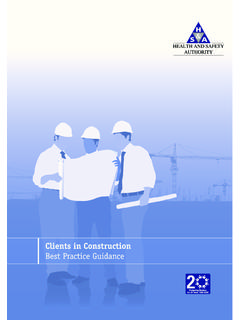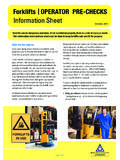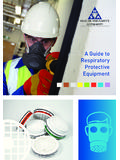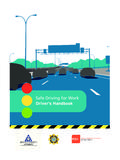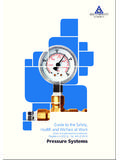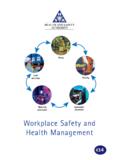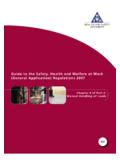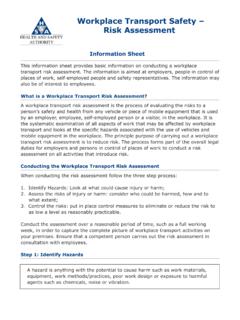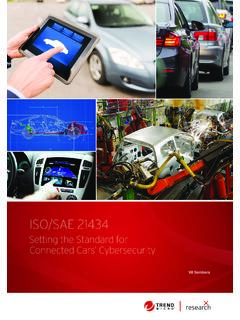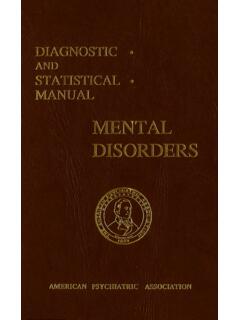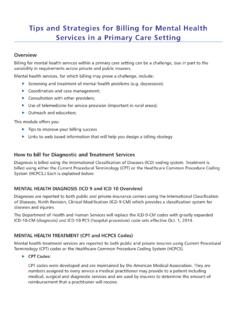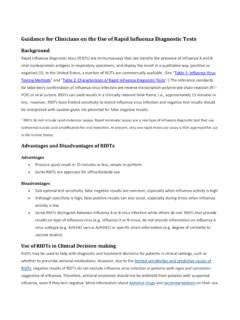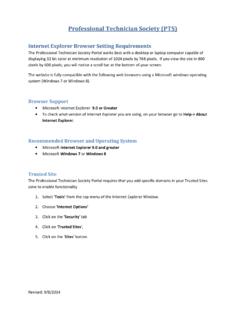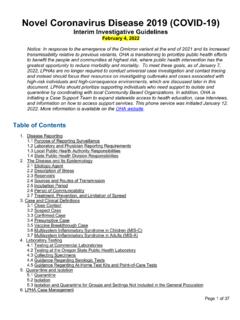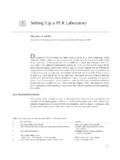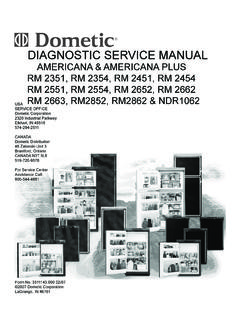Transcription of COVID-19 Work Safely Protocol - hsa.ie
1 COVID-19 - Good Practice Checklist An t dar s Sl inte agus S bh ilteachta Health and Safety Authority Rapid Antigen Diagnostic Tests (RADTs). These checklists have been prepared to help employers, business owners and managers to get their business up and running again in a way that will help prevent the spread of COVID-19 . This checklist will help employers who are considering setting up a RADT programme in their workplace. This checklist will help employers who are considering the use of a RADT programme in their workplace. The key reason to use such tests is as an aid to public health in identifying cases of COVID-19 . Further information can be found at , , and No. Control Yes No Action Required Procedures and Information 1 Have you had a look at Section 2.
2 C10, Transitional Protocol : Good Practice Guidance for Continuing to Prevent the Spread of COVID-19 on Antigen Diagnostic Tests (ADTs) and Rapid Antigen Diagnostic Tests (RADTs). 2 Have you consulted on the implementation of RADTs with the workers and their representatives (the Lead Worker Representative(s) and the safety representative(s)) before introducing a RADT regime? 3 Have you explained to workers that RADTs are voluntary and that they do not have to participate in testing? 4 Has existing and any emerging public health information in relation to RADTs been taken account of? 5 Before establishing RADT have you discussed and agreed the implementation and administration with the workers and their representatives (the lead worker representative(s) and the safety representative(s))?
3 6 Have you established whether an internal or external run programme of RADT is most suited to your business? 7 Have you considered the administration and resources burden to manage the programme, such as swabbing, recording, reporting, communications and testing involved in implementing the programme? 8 Have you considered whether contractors and visitors to the workplace should also be included in the testing? 1 31 January 2022. COVID-19 - Good Practice Checklist Rapid Antigen Diagnostic Tests RADTs No. Control Yes No Action Required 9 Has the manufacturer's product information/instructions for use (IFU) been consulted and checked in order to select the most appropriate RADT for the programme? 10 Has the required frequency of testing, for example, daily or twice weekly, been established based on the business' needs?
4 11 Has a written occupational health and safety risk assessment been completed for this new work activity and the specific risks of using RADTs in the workplace? 12 Have the risk assessment control measures taken account of public health recommendations and the test manufacturer's instructions for use? 13 Has a process been put in place for staff who do not want to participate in testing? 14 Has the COVID-19 Response Plan been updated to take account of the agreed testing policy and approach taken? 15 Has the updated plan, the agreed testing policy and approach been communicated to all workers? 16 Have any other existing policies and procedures been reviewed and revised, in consultation with workers and their representatives, as necessary? 17 Have these updated policies and procedures been communicated to all?
5 18 Have all staff engaged in RADT testing been provided with training so that they can undertake the tests Safely and correctly? 19 Is appropriate supervision in place to ensure competency of those engaged in the testing? 20 Where tests are self-administered, is retraining provided to ensure quality assurance and competency? 21 Are appropriate procedures in place for disinfection and waste disposal? 22 If there is an occupational health or medical service in the workplace, did you get advice from them before establishing a programme of testing? 23 Are clear and agreed procedures in place to support management of positive cases detected, including access to confirmatory PCR testing? 2. COVID-19 - Good Practice Checklist Rapid Antigen Diagnostic Tests RADTs No.
6 Control Yes No Action Required 24 Are instructions available to workers on what to do in the case of either a negative, a positive or an invalid test? 25 Are workers clear that they must stay at home if displaying any symptoms of COVID-19 . Are they aware that they must follow public health advice in this regard? 26 Is personal information collected in line with General Data Protection Regulation (GDPR) requirements? 27 Have you communicated the importance of continuing to follow public health advice in relation to hand washing, respiratory etiquette and other measures to workers? 28 Are there procedures in place for monitoring the use of RADT activity in the workplace for example the number of tests performed, positive, negative, and invalid results?
7 29 Is there a policy to determine the conclusion of any RADT testing programme? 30 Where workers are using RADTs, have you informed them of the control measures in the safe use and disposal of test materials and hazardous fluids? Additional Information See Section 2: C10, Transitional Protocol : Good Practice Guidance A list of RADTs with a CE-Marking and which are available on the EU market can be found on the Joint Research Centre (JRC) homepage: ( ). There is no central approval system for in vitro diagnostic medical devices in the EU and as such this database does not provide a list of authorised or approved devices in the European Union. If a company proposes using self-test RADTs in the future ( once these are CE-marked for use on the EU and Irish market), the employer will need to consider if the worker will complete the test at home and if agreed, what additional measures may be needed.
8 For example, how the worker should be trained and how to dispose of any biological waste. Name: Signature: Date: The information contained in this checklist is for guidance purposes only and is non-exhaustive. It is not intended to provide legal advice to you, and you should not rely upon the information to provide any such advice. We do not provide any warranty, express or implied, of its accuracy or completeness. The Health and Safety Authority shall not be liable in any manner or to any extent for any direct, indirect, special, incidental or consequential damages, losses or expenses arising out of the use of this checklist. 3.
